RAIDIX 5.X for GIGABYTE platforms
With GIGABYTE platforms, the RAIDIX team have come up with enterprise-scale software solutions that can make a huge difference for a business, both technological and financial. RAIDIX 5.X software enables all-flash and hybrid storage with a high-speed block (SAN) and file (NAS) access deployment.
Email Sales
Experience RAIDIX 5.X for GIGABYTE platforms
RAIDIX 5.X software enables you to deploy all-flash and hybrid storage with a high-speed block (SAN) and file (NAS) access. Empowered by innovative RAID technologies, RAIDIX provides stable workflow and outstanding performance for data-intensive tasks.
In cooperation with GIGABYTE, the RAIDIX team have come up with a number of enterprise-scale software solutions that can make a huge difference for a business, both technological and financial.
In cooperation with GIGABYTE, the RAIDIX team have come up with a number of enterprise-scale software solutions that can make a huge difference for a business, both technological and financial.
RAIDIX 5.X + GIGABYTE Solutions
Ultra-high bandwidth for the most demanding tasks
Internal logic of RAIDIX storage arrays was originally developed to get maximum benefits for working with massive sequential workloads.
The lowest impact of hardware failures
RAIDIX has dual controller configuration to eliminate single point of failure and prevent impact from the most common hardware failures.
Easy integration into existing infrastructure
RAIDIX data storage works with any drive from any vendor. Software-driven architecture eliminates storage vendor lock-in.
NearLine Media Solution
NearLine storage is a great configuration for ‘cold-ish’ data, not ready to be archived yet. GIGABYTE-RAIDIX joint solution is ready to keep the data safe, with overall costs such as $50/TB, using fast SAS/SATA SSDs.
Tech Features
• Scalability up to 9 PB
Tech Features
• Scalability up to 9 PB
• Stable high read performance
• Proprietary RAID 7.3, N+M levels
• Wide range of supported interfaces
Business Impact
• Reduces costs and complexity of modern workflows
• Guarantees the availability and preservation of very expensive content with minimal investment in infrastructure
• Reducing the time required to implement centralized storage
• Low storage footprint
Business Impact
• Reduces costs and complexity of modern workflows
• Guarantees the availability and preservation of very expensive content with minimal investment in infrastructure
• Reducing the time required to implement centralized storage
• Low storage footprint

HPC Storage & AI Solution
Enterprise-scale solution improves the cluster efficiency by up to 30%, which leads to an overall saving of 50% of the storage system's TCO. Efficiency is provided by patented RAIDIX algorithms, implemented in RAIDIX 5.X.
Tech Features
Business Impact
• Less time to get insight
• Less time to teach NL
• The minimum entry point
• Fully integrated solution from single hands
Tech Features
• Random IOPS optimization
• Lustre/BeeGFS integration
Business Impact
• Less time to get insight
• Less time to teach NL
• The minimum entry point
• Fully integrated solution from single hands
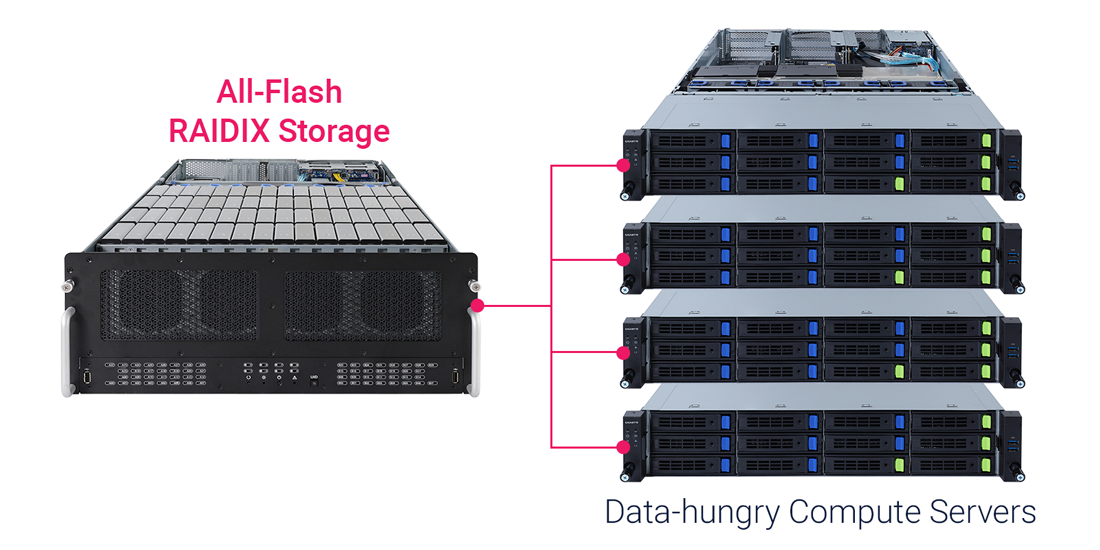
Enterprise Backup Target
While many see backup storage as something you should not splash out on, this part of a storage system becomes decisive when trouble comes (as it usually does). As a result, cheaper backup hardware often fails to provide full recovery.
GIGABYTE-RAIDIX joint solution has a smart way to go about it, as it checks the backup data regularly, and substitutes it if necessary. As a result, RPO and RTO fall dramatically.
Also, the solution provides a much better performance rate than competitors: as it provides scalability up to 9 PB (4x better), write speed 70TB/hr (average market 50TB/hr), and the proprietary RAID N+M level.
Tech Features
GIGABYTE-RAIDIX joint solution has a smart way to go about it, as it checks the backup data regularly, and substitutes it if necessary. As a result, RPO and RTO fall dramatically.
Also, the solution provides a much better performance rate than competitors: as it provides scalability up to 9 PB (4x better), write speed 70TB/hr (average market 50TB/hr), and the proprietary RAID N+M level.
Tech Features
• Scalability up to 9 PB
• Proprietary RAID 7.3, N+M levels
• High write bandwidth
Business Impact
• Improves RPO/RTO
• Low TCO
• Low storage footprint
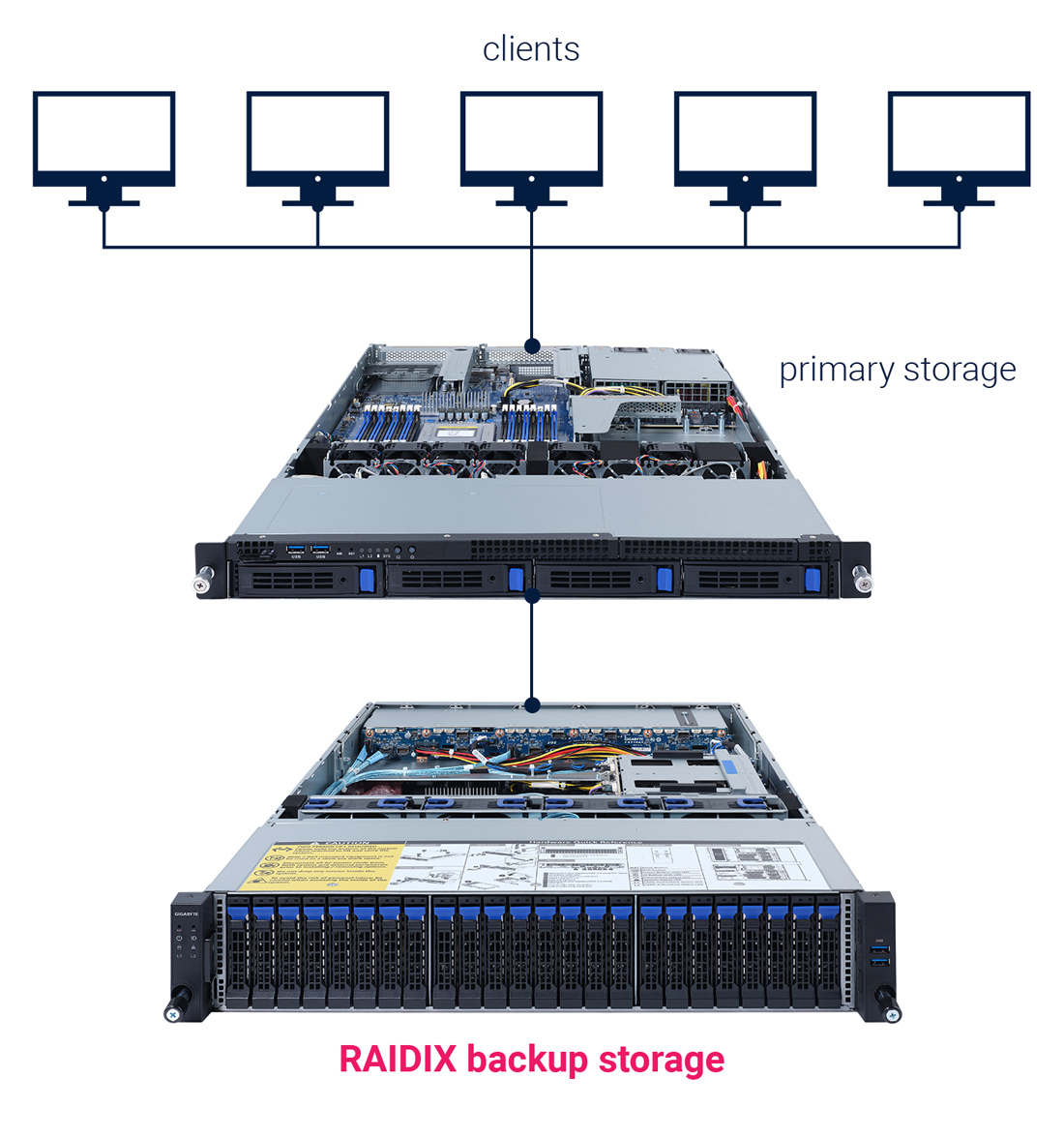
Large Video Surveillance Solutions
As VSS gets bigger and more complicated, the demand for fast archive access grows. GIGABYTE-RAIDIX delivers undisruptive archive access, which saves time and money necessary for ensuring safety.
Tech Features
• Scalability up to 9 PB
• Proprietary RAID 7.3, N+M levels
• High write bandwidth
Business Impact
• Reliable archive access
• Optimized data workflow leading to less TCO on large projects
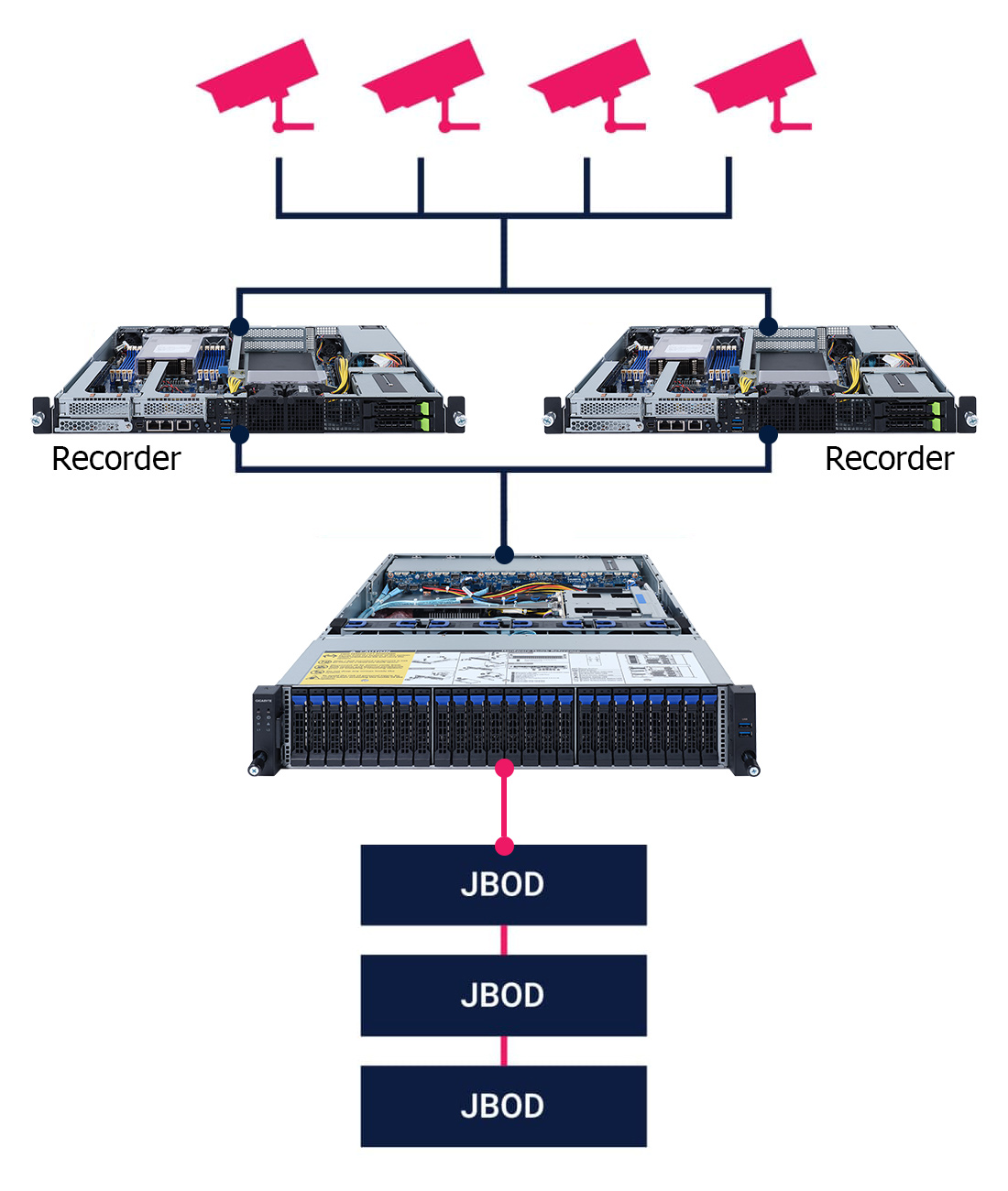
Tier 2 Storage Apps
Tier 2 Storage Apps
Tier 2 applications may take up a lot of storage space. Joint GIGABYTE-RAIDIX solution brings cost-effectiveness to those apps with storage costs at just 50$/TB.
Tech Features
• Proprietary RAID 7.3, N+M levels
• High Write Bandwidth
Business Impact
• Low TCO
• Low storage footprint
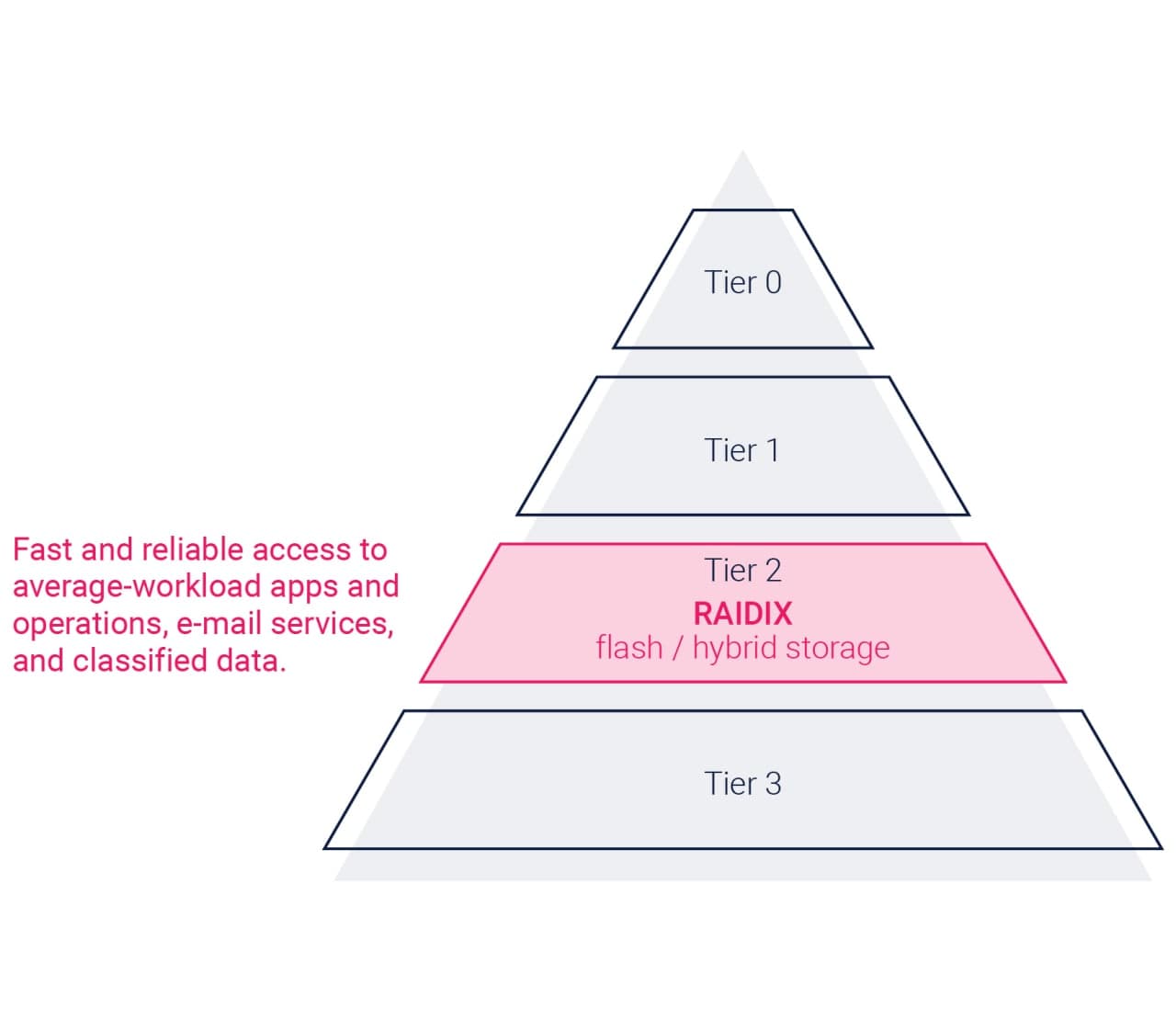
All-flash Media Storage
Introduction of new media production technologies leads to better quality — and bigger volumes, and expenses tend to grow similarly. But with All-Flash Media Storage solution by GIGABYTE and RAIDIX you will be ready to work with 16k, with no additional investments needed. Implementation of Hi-End AFA is also possible with the same standard components.
Tech Features
• High Bandwidth (up to 40GBps)
• Random IOPS optimization
Business Impact
• 4k/8k editing and finishing at low cost
• Reducing the time required for rendering, which leads to reduction in costs
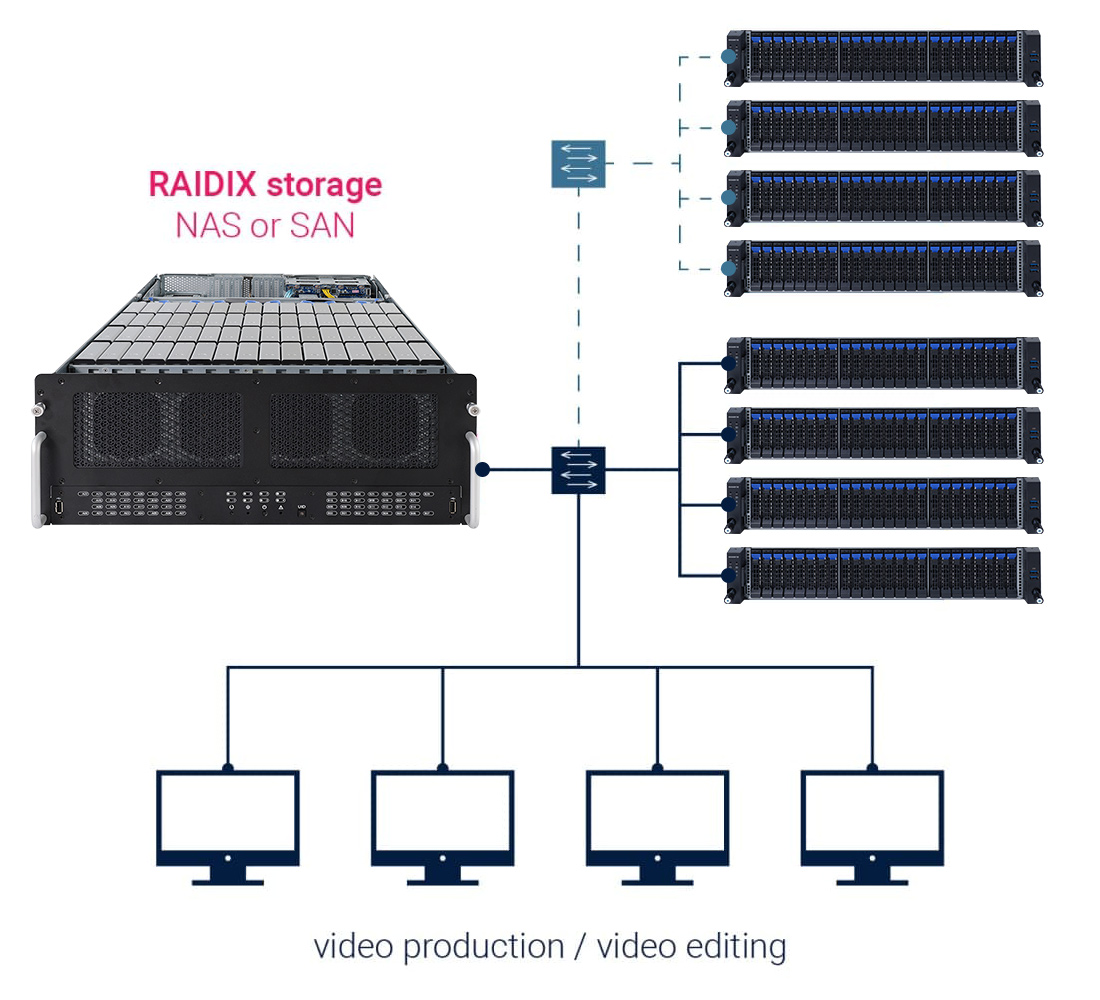
What else RAIDIX 5.X has to offer?
Ultra-high bandwidth for the most demanding tasks
Internal logic of RAIDIX storage arrays was originally developed to get maximum benefits for working with massive sequential workloads. It significantly boosts HDDs performance even in low-end storage systems.
To interoperate with solid state drives, RAIDIX storage uses ERA Engine, an innovative software RAID with I/O handling parallelization and lockless data path. These features raise up storage performance to the level of flash potential bandwidth. Moreover, the system shows high IOps and low latency even in mixed I/O workloads like VDI and financial transaction processing.
Internal logic of RAIDIX storage arrays was originally developed to get maximum benefits for working with massive sequential workloads. It significantly boosts HDDs performance even in low-end storage systems.
To interoperate with solid state drives, RAIDIX storage uses ERA Engine, an innovative software RAID with I/O handling parallelization and lockless data path. These features raise up storage performance to the level of flash potential bandwidth. Moreover, the system shows high IOps and low latency even in mixed I/O workloads like VDI and financial transaction processing.
The lowest impact of hardware failures
Driven by innovative RAID technologies, RAIDIX storage demonstrates minimum performance penalty when a drive goes out. It helps to maintain smooth application workflow and data integrity in case of emergency.
RAIDIX has dual controller configuration to eliminate single point of failure and prevent impact from the most common hardware failures.
To protect data from natural and man-driven disasters, RAIDIX can create synchronized copies of data in a secondary data center.
Easy integration into existing infrastructure
RAIDIX storage provides access via file (NFS, SMB, AFP, FTP) or block (FC, IB, iSCSI, iSER, SAS) protocols*.
To provide more hardware freedom, RAIDIX data storage works with any drive from any vendor. Software-driven architecture eliminates storage vendor lock-in and minimizes costs of regular hardware modernizations.
*file and block protocols cannot be provided at the same time
Compatibility
1/12
Servers for Dual-Controller Configurations
Rack Server - AMD EPYC™ 7002 - 2U UP 2 x PCIe Gen4 GPUs
2/12
Servers for Dual-Controller Configurations
Rack Server - AMD EPYC™ 7003 - 2U UP 14-Bay SATA/SAS
| Application:
Networking
&
Hybrid/Private Cloud Server
3/12
Servers for Dual-Controller Configurations
Rack Server - AMD EPYC™ 7003/7002 - 2U UP 12+2-Bay SATA/SAS
| Application:
Networking
&
Hybrid/Private Cloud Server
4/12
Servers for Dual-Controller Configurations
Rack Serve - AMD EPYC™ 7002/7001 - 2U UP 12+2-Bay SATA/SAS
5/12
Servers for Dual-Controller Configurations
Rack Server - 2nd/1st Gen Intel® Xeon® Scalable - 2U DP 12+2-Bay SATA/SAS
6/12
Servers for HDD single-controller storage
4U 38-Bay Dual Processors Storage Server (Intel)
7/12
Servers for HDD single-controller storage
Storage Server - AMD EPYC™ 7003/7002 - 4U UP 42-Bay NVMe/SATA/SAS
| Application:
Storage
8/12
Servers for HDD single-controller storage
4U 60-Bay Dual Processors Storage Server (Intel)
9/12
Servers for single-controller NVMe configuration
Rack Server - AMD EPYC™ 7003/7002 - 2U UP 24+2-Bay Gen3 NVMe/SATA/SAS
| Application:
Networking
10/12
Servers for single-controller NVMe configuration
Rack Server - AMD EPYC™ 7003/7002 - 2U UP 24+2-Bay Gen4 NVMe/SATA/SAS
| Application:
Networking
11/12
Servers for single-controller NVMe configuration
Rack Server - 2nd/1st Gen Intel® Xeon® Scalable - 2U DP 24+2-Bay Gen3 NVMe/SATA/SAS
12/12
Servers for single-controller NVMe configuration
Rack Server - AMD EPYC™ 7002/7001 - 1U DP 10-Bay Gen3 NVMe
Related Technologies
Software Defined Storage ("SDS") refers to the virtualization of storage systems, whereby the underlying storage hardware is abstracted from the storage software that manages it. SDS can be an element with a Software Defined Data Center or it can also function as a stand-alone technology. The software enabling the storage-defined storage environment may also provide policy management for features such as data de-duplication, replication, thin provisioning, snapshots and backup.
NVMe is a type of software interface used for solid state drives (SSD), and stands for “Non-Volatile Memory - Express” (Non-Volatile Memory is a common form of flash memory found in SSD). The formal name of NVMe is the Non-Volatile Memory Host Controller Interface Specification. Compared to the older AHCI (Advanced Host Controller Interface) used for traditional mechanical spinning SATA hard disks, NVMe is adapted for use with SSD through a PCIe hardware interface, resulting in a much faster disk interface protocol.
An all-flash storage system, also know as an all-flash array (AFA) or a solid-state storage disk (SSD) system, is an external storage array that uses only flash media devices (such as NVMe or SATA SSD) for storage. Flash storage is used in place of spinning hard disk drives (HDDs) that have long been associated with networked storage systems. Benefits of using all-flash storage systems include lower latency, higher IOPS, greater storage density and reduced power consumption compared with mechanical HDDs.
Jokingly termed the "Redundant Array of Inexpensive Disks" by researchers in the 1980s, the acronym RAID was later modified to stand for "Redundant Array of Independent Disks". It is a method of virtualization that combines multiple disks into a single storage unit to ensure availability and achieve redundancy. Data is stored across multiple devices to prevent the failure of any one disk from destroying the information. Hardware or software solutions are used to manage the data that's distributed across multiple devices.
RAID has become a key feature in many modern storage devices; most notably, in storage servers that are part of a computing cluster that handles a lot of data. The Storage Networking Industry Association (SNIA) categorizes RAID into different levels to specify which storage techniques are being used; the most ubiquitous RAID types are 1, 3, 5, and 6. A higher level generally represents greater protection against data errors and device failures. Data center engineers usually employ a mix of RAID levels and other error protection technologies to ensure data redundancy and improve efficiency.
Bring Your Ideas Faster to Fruition
Email Sales





































